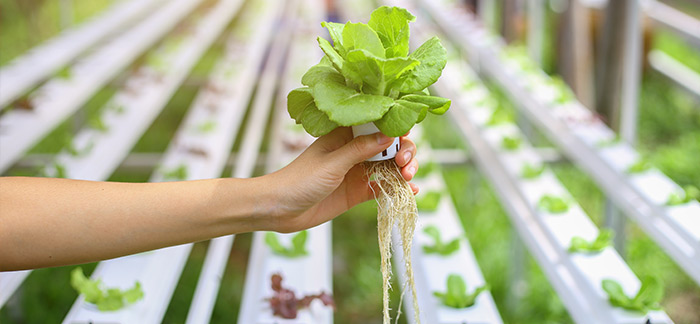
As daunting as ‘hydroponic farming’ sounds, it’s actually pretty simple. So simple in fact, that you shouldn’t hesitate to try it in your own home.
By definition, hydroponics is the growing of plants in a water-based, nutrient-rich solution, rather than in ordinary soil. The plants’ root systems are supported using an inert medium such as perlite, rockwool, clay pellets, or vermiculite.

Home-based hydroponics has soared in popularity over the last decade, mostly because it’s a hugely rewarding hobby and an increasing number of people are attempting to grow their own fruit and vegetables.
One of the core drivers behind this trend is mounting concern over the use of pesticides on food grown on commercial farms, and also the ballooning use of genetically modified (GMO) seeds.
Besides knowing what you’re growing (and eating) is pesticide-free and non-GMO, hydroponic farming offers a range of other compelling advantages, some of which include:
- Plant growth rates and yield are often at least 20% higher than the equivalents in soil;
- It is available to people who do not have gardens or access to soil;
- The plants don’t require as much space as their soil counterparts because their roots are surrounded by oxygenated, nutrient-rich water solution which minimises root spread;
- It uses significantly less water due to negligible evaporation and zero drainage; and
- There are next-to-no soil-borne diseases, pests and weeds within the highly controlled hydroponic environment.
Where to start?
Although there are various hydroponic methods, we will focus on the simplest one … Deep Water Culture (DWC). The best advice of all is to start small. Only once you’ve mastered a small-scale hydroponics farm, should you consider the expansion of your farm.
The first step is to buy some seedlings and a mini DWC kit. These are compact systems that are simple to use and perfect for first-time hydroponic hobbyists. Once assembled, fill up the reservoir with the nutrient solution recommended for your seedlings.
Then, suspend the roots of your seedlings into the solution giving them access to water, nutrients and dissolved oxygen.
DWC kits are usually supplied with an air pump and airstone to aerate the water and provide a continuous supply of oxygen to the seedlings’ roots. Without this ‘oxygenation’ of the water, the plants’ roots will drown. Thus, it’s imperative that the pump runs continuously or as close to continuous as possible.
The only other resources your seedlings need are sufficient light (minimum six hours of sunlight per day), and an ambient temperature environment – both of which are simple enough to maintain. In the absence of real sunlight, artificial lighting with a similar light spectrum and timing to that of the sun will be required.
What can I grow?

Although you can grow just about anything in your hydroponics farm, here are some of the best options to start with: tomatoes, lettuce, cucumbers, spring onions, peppers, spinach, strawberries, blueberries, basil and coriander.
And, the fact that your farm is indoors, means that your plants are not subject to growing seasons. Yes, you can grow whatever you want whenever you want.
What are you waiting for?
The time is now … take the plant by the roots and immerse yourself and your home in the eco-friendly, healthy and rewarding world of hydroponics farming.
Date Published: 25 May 2018
